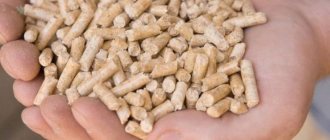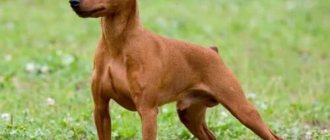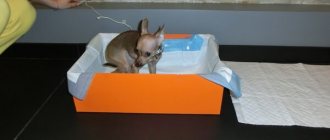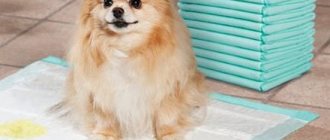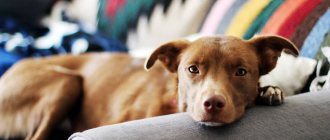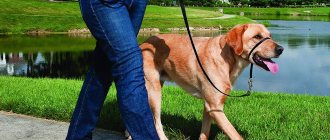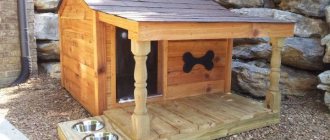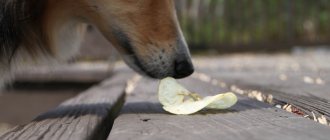How to train a puppy to go to the toilet outside is one of the most important questions that every owner must decide when getting a pet. Like many animals, the main “sanitary” rule for dogs is not to defecate where they sleep. Consequently, they have no need to go outside to the toilet, and if the owner wants to instill such behavior in his four-legged friend, it is important to train him correctly. Both very young and adult dogs have their own specific training requirements. Let's look at both options.
When should you start teaching your puppy to go to the toilet outside?
You can teach a puppy to use the toilet outside the home from the time when he can go for full walks and his body is sufficiently formed so that he can control himself in matters of toileting.
As you know, until the pet has received its first vaccinations, it is necessary to go outside with it, rather, in order to acquaint it with the environment. Your four-legged friend should be held in your arms and not allowed to communicate with other animals and people. It is logical that it is impossible to teach a dog to go to the toilet on the street in such conditions.
The vaccination campaign ends with the third vaccination when the dog is 3 months old. After the 10th quarantine, you can go for walks - usually she is about 3.5 months old at this time. In addition, from about 4 months of age, puppies physiologically develop to the point of being able to endure leaving the house rather than making a toilet at the nearest point. An excellent age for teaching sanitary walks!
How to train a puppy to ask to go outside?
As soon as all vaccinations are completed and the quarantine period is over, you can start walking the puppy and teach him to go outside when he needs to. But do not delude yourself that the dog will immediately begin to defecate only during a walk. We'll have to be patient. The adjustment period will take from several weeks to several months, depending on the breed and temperament of the baby. However, the correct behavior tactics of the dog owner will help bring this moment somewhat closer. The basic rules are as follows:
- As soon as the puppy wakes up, immediately take him outside. After eating, take it out again. At first, you can take a diaper with you so that he can quickly find his bearings and not be distracted by unusual smells;
- It is recommended to walk a small pet 5–6 times a day, sticking to approximately the same time;
- after each successful defecation on the street, the puppy must be praised and rewarded with a treat;
- After the dog has done its “business,” you can play with it or allow it to communicate with other relatives, making it clear that all pleasures are possible only after the toilet.
Preparing for training
First, some tips for owners:
- be patient. No matter how smart a dog is, it will take time for it to understand what you want from it and learn to tolerate it until the street. Be prepared in advance that the learning process may not be too fast;
- Make a feeding plan (preferably together with your veterinarian). Determine the optimal portion size and how many feedings per day are needed. Give meals on a schedule and do not allow your four-legged friend to eat between scheduled meals. Puppies have very fast metabolisms, and the more often they eat, the more often you will need to go out;
- Prepare in advance a particularly tasty treat with which you will reward your dog for doing things outside. It's worth keeping it somewhere where you can grab it very quickly when you're about to go out with your puppy. Treats should be small (about the size of a fingernail). For each trip to the toilet - 3-5 pieces;
- in some cases, treats alone are not enough for motivation. Think about what would be a good motivation for your pet.
It is best to start training on vacation or at least on weekends - you should be at home all day and be able to take the puppy out many times. And once you start training, don’t quit halfway.
How to teach a puppy to go to the toilet outside
So, you have chosen the time when the puppy can go outside, you have the opportunity to devote the whole day (and probably even the night) to him. You made a feeding schedule and stuck to it. You can start training!
Your main task is to understand when your pet wants to go to the toilet, and when you notice the first signs, quickly put it on a leash and go outside. Usually dogs need this after sleep, meals, physical activity and active games. The behavior of your four-legged friend will tell you about the impending need - he can spin in place, sniff, and squat. If you spend enough time with your dog, you will learn to recognize these signs.
When outside, find a quiet and peaceful place where your pet will not be distracted by anyone - neither other animals, nor people, nor toys. Often the owner himself turns the attention: like all children, puppies are easily distracted, so do not pull the leash, do not call, play or talk to the dog. Just walk back and forth and let her go to the toilet in peace. Be patient, even if a lot of time has passed and there is no result yet. When you notice that the dog has begun to do its business, quietly praise it, and when it finishes, reward it with a treat. Now you can play, take a walk, etc.
Such exits should be arranged every time the pet shows a desire to go to the toilet. Stick to the algorithm for at least a few days so that the puppy clearly understands what is required of him. If you have already started training, don’t be lazy and don’t let “one more time at home, it’s okay.” Such relaxations will not lead to effective results and will only prolong the overall training time.
As with feeding, it is also worth creating a schedule for sanitary trips. Usually this is 6-12 exits, depending on the pet’s age, training, and breed. Be sure to stick to your chosen schedule! At least a few days until the puppy gets used to it.
A few tips: how to train a puppy to go to the toilet outside
A soft bed and bright toys have been purchased, you have stocked up on food for the puppy, and purchased cute bowls. We ordered a wooden basket for the sun lounger and bought the most beautiful harness and leash. Everything is ready for the appearance of the cute bear cub, everyone is excited!
Happiness in your new home!
This is a wonderful time to prepare for the arrival of your baby. But don't forget the simplest thing: your puppy is a living creature. He has normal biological functions. This must be understood and taken into account until a tiny lump appears in your home. And every family member should keep this in mind. Otherwise, after three weeks of sleep deprivation, you will realize that you were not prepared for such a turn of events. So, initially taking into account all the nuances and characteristics of a small puppy in the house is the key to success.
Bottom line: Be prepared for changes in your life. Consider all the nuances of the arrival of a new “child” in the house.
20 minute rule
So a little bundle of happiness has appeared in your home! If your baby is drinking and eating, or just running around the house, take him outside every 20 minutes.
If the baby runs, plays, chews bones, go out with him every 20 minutes. Every time the puppy is active, follow the rule: after 20 minutes we go outside.
When do we not apply this rule? When the baby is sleeping.
If you live in a warm climate, then following the rule is quite simple. If you live in a cold place, prepare special clothes and leave them at the front door - this will make it easier for you to go outside every 20 minutes. If you missed the exit, don't worry. Now you are one of the many owners of puppies who are standing ankle-deep in the snow and waiting for the baby to finally do his business.
As your puppy gets older, you will gain experience, become observant, and you will not need to run outside as often.
Bottom line: be prepared for very frequent trips outside with your baby. The sooner he understands that he needs to pee outside, the sooner you will solve the problem with the toilet outside the house.
Raising a puppy day and night
During the day, stick to the 20-minute rule, except when your dog is sleeping.
At night, it is recommended that you take your canine child to his sleeping basket or playpen. This is especially important if the urge to go to the toilet begins. If the puppy's breeder or mother did everything right in the past, the baby will whine. He will want to leave his house. And this is a very good sign, as it makes the task of toilet training much easier!
As dogs develop and mature, they will become less and less likely to need to eliminate in the middle of the night.
Bottom line: It is recommended that you use a fenced-in area for your dog to sleep at night. When the puppy wants to go to the toilet, he will have to give a signal to come out of his shelter.
Door training
How do you know when your growing baby needs to go outside?
Some dog owners use a bell on a leather cord and hang it from the doorknob to the floor. Every time the door opens the bell rings. This method will help the puppy learn: in order to go outside, the bell must play. Your puppy will definitely be playing with the tinkling bell for a while. But after a while, he will begin to associate the connection between the ringing and going outside. Until then, you need to stick to the 20-minute schedule. Consistency will only strengthen your training.
Bottom line: use a marker signal to develop an association in the animal when going outside.
Where to go?
It's best if you let your puppy show you where the best place to go to the toilet is. Dog children quite clearly explain where they would like to do their business. Some people like to be closer to home, while others need privacy. Others need a certain environment to feel comfortable. And some people need to walk a couple of blocks, and only after that do their business.
Pet diapers are now sold in stores. And there are owners who find a way out of this - their animal goes to the toilet in a film or in a tray during the day. Yes, while the baby cannot control urination, you can resort to the help of such means. After all, it takes a lot of time to take a puppy outside. Sometimes there are such situations that it is simply impossible to run from home to the park in time. In such cases, you can keep a puppy-scented litter box or diaper by the front door or in the litter compartment. It makes life easier.
But it is strongly not recommended to keep them in every room. If you teach your puppy to run to any room when he needs to, you won’t envy yourself. In this case, all your energy spent on accustoming you to the street will disappear into oblivion for a long time.
Bottom line: you can train your puppy to use a diaper or a litter box. But treat this only as help while raising a dog.
street space
If your baby goes outside to relieve himself, you must accompany him. Firstly, it’s safer, and secondly, you will make sure that the puppy has done his job accurately. The attention of children is very scattered and the squeak of a mosquito can distract him from pressing matters.
Each dog has its own behavioral characteristics. The owner should know about this. Does the animal go straight to empty its bowels and bladder, or does it need to walk for about 20 minutes first?
If you live in a private house and the space is fenced, then decide for yourself whether you will use a leash or not. If you are walking in a common area, walking on a leash is mandatory for safety.
Bottom line: you are the teacher and must supervise the baby. And also don’t forget about safety!
Celebrate big events!
At the initial stage, when the dog is preparing to go to the toilet, use the phrase marker. You can come up with any: do your business, go to the toilet. It doesn't really matter what you say. The phrase should be such that you can use it anywhere.
When your baby has done things, praise him. You can walk a little longer before going home. Some people use treats for training, but this is not recommended when taming a puppy. There are cases when children-dogs grab the combination on the fly - relieved - hold the treat. And as a result, they go to the toilet both at home and on the street. So it’s better to come up with other markers that will let the puppy know: you did the work - you’re a good dog!
After a while, you will be able to let the dog off the leash, say marker words, thereby making it clear what is needed and step aside, knowing that the dog has completed all its tasks. But this will happen over time, so don't overdo it in the beginning. This is a gradual process - the result of your consistent actions and the puppy's maturation.
How long will it take to train?
Set yourself up for success, take your time. Wait a minute though. If you set time limits for your puppy, you are setting yourself up for disappointment.
Just accept the puppy into your life as a given, and the whole period will go more smoothly. A dog's maturation is a natural process; there is no need to put pressure on it.
Bottom line: when the dog did everything right, don’t skimp on praise! The baby is learning and wants to please you!
How to deal with unexpected surprises?
So, you do everything right, stick to the schedule. Go outside every 20 minutes and enclose the puppy at night. But still have troubles at home? They definitely have their place. And perhaps more than once.
Unpleasant surprises - happening once or more - mean that you need to check: are you doing everything right? If there is a weak link somewhere, this is the answer to unpleasant surprises.
Don't be upset if the puppy didn't make it outside. Always remember that everything that goes in with food must come out. Just clean up the puddle, smile and be glad that everything is fine with the puppy’s health. And don't forget to set a timer for 20 minutes.
And yet, from time to time, troubles can indicate something else. If your training system is working properly, there may be medical problems. The reason may be unsuitable food. Or your puppy can't keep up with your schedule. Some people need a little more time for psychological and physiological processes and everything will work out. Vigilance and observation will help you understand the reason.
And finally, just enjoy. Seriously, enjoy this time—as long as you can hold and cuddle this little furball. Education and toilet training is an important part of a child's growing up. But, like all children, they grow up so quickly!
How to stop going to the toilet at home
An important part of training is to get the dog to stop using your home for sanitary purposes. The following tips will help:
- Lock your puppy in a crate at night and while you are away. As already mentioned, the animal does not go about business where it sleeps. Accordingly, locking him in a limited space, in fact, you leave him no choice but to endure. However, the cage should under no circumstances be an alternative to learning! Don't put your dog there too often or for too long. Your four-legged friend needs you, your care and physical activity. If, while in a crate at night, the dog begins to howl, take it outside. Although this behavior may also mean that the pet simply needed your attention.
- Carefully clean areas already “marked” by the puppy, using appropriate products from pet stores. Unlike ordinary detergents, specialized ones will completely remove the odor. Animals tend to return to the place where they have already arranged a toilet for themselves, so do not give your pet unnecessary temptations.
If possible, it is better to remove carpets for a while, as it is very difficult to remove odors from them.
- If you find excrement in the house, do not throw it away immediately - take it with you to the sanitary exit, put it in the right place and bring the dog to smell it. This will help her go to the toilet outside.
- If you catch your puppy doing things around the house, don't yell at him. Instead, gently interrupt, you can say “No, no!”, clap your hands. After that, put on a leash and go outside. Don't forget to reward your pet when he finishes what he started.
The popular method of “poking” pets with their muzzles is their “mistakes”. This is a completely wrong approach and will not lead to the desired results. Also, you should not punish puppies if they were not patient or made a mistake, for example, during the game. Like children, they still have little bladder control (dogs begin to do this at 4-6 months). If you punish for “incidents,” the puppy understands that you are unhappy, but will not be able to change its physiology. Therefore, there is a high chance that he will simply begin to be afraid of you and choose more secluded corners for sanitary purposes.
Common problems and their solutions
No. 1. Puppy keeps peeing at home or defecating in crate
- If training does not bear fruit, most likely you are not training your pet well enough, you have set the schedule incorrectly, and you cannot catch the moment when you need to go out. Adjust basic aspects of training and consult your veterinarian if necessary.
- If the puppy is toileting in the crate, it is likely too large and the dog has the opportunity to create a “bedroom” and a “sanitary area” for himself. The optimal size is such that the animal can lie, stand and sit freely. If the area has nothing to do with it, it’s worth going to see a veterinarian. Perhaps the puppy was previously crated for too long and had no choice but to misuse the space provided. This behavior requires correction, but it can be difficult to do this without a specialist. In addition, the desire to roll in one's own excrement and other atypical habits may be associated with certain diseases.
No. 2. You can't catch the moment when you have to go outside
- Stay close to your puppy at all times. Temporarily limit his movement around the apartment so that he is in the same room with you - close the doors, place special gates in the openings.
- If you still can't, use a cage. But in moderation!
No. 3. The puppy does not want to pee outside; he walks and plays instead of satisfying sanitary needs
- Some owners o. Wait at least 10 minutes and do not distract the puppy with anything. If nothing happens, return home and try again in another 10-15 minutes. Sometimes a third try is required.
- Check that the leash is 2 m long.
- Often the puppy does not go to the toilet because the owner distracts him - he switches the animal’s attention to himself. To avoid getting in the way, just wander back and forth. Don't talk to the dog or try to play.
- Make sure your four-legged friend has no other distractions - toys, other dogs.
How to train an adult dog
To teach an adult dog to go to the toilet outside, follow these tips:
- If she previously lived in a house and not in a booth, her “mistakes” are most likely associated with stress from moving to you , from a new environment, etc. In this case, you can lightly scold your pet for “mistakes”, but do not punish him. In general, your task is to help him adapt. The sooner this happens, the sooner the behavior will return to normal.
- If the dog previously lived in a kennel, he is not accustomed to the fact that he cannot have a toilet in any place convenient for him and must wait until he goes outside. In this case, the pet will actually have to be trained from scratch. The technique is generally the same as in the case of puppies, but there are two important features. On the one hand, adult animals do not need to be taken out so often - usually 3-4 times are enough for them. On the other hand, training them is not as easy as puppies because they already have established habits and behaviors. You may need professional help to change them.
If enough time has passed since the move and you are unable to train your pet, this is a reason to see a veterinarian. Also, you should not ignore the visit if the dog suddenly changed its behavior and, having seemingly learned to walk outside, began to make sanitary stops in the house again. And if you have a male dog who is marking his territory, consider neutering.
How to train a puppy to walk?
While the puppy is small and vaccinations have not been completed, the puppy cannot be walked every day. Therefore, you have to clean up after him every day, which takes a lot of time.
You can simplify the solution to the problem by using disposable diapers instead of rags or newspapers. They absorb moisture well, and the puppy quickly gets used to such a toilet. It is enough to notice exactly where he has adapted to do his business, and simply put a diaper in this place. The next time the puppy starts to get ready, take him to the diaper and make sure everything happens there.
Several such lessons will help him remember the new rule better.
If the puppy has chosen several places for “walking”, then there should be diapers there too. But there should not be more than two places, otherwise he will not understand where his toilet is.
Sometimes the puppy persists and does not want to go to diapers. In this case, you need to ask the breeder what kind of dog litter he used. Not all breeders buy disposable diapers; this is too expensive when raising a whole litter of puppies. Therefore, breeders can replace diapers with newspapers or rags.
In order for the puppy to get used to diapers, at first you need to lay down a material that is more familiar to him, and put a diaper on top. Puppies usually understand pretty quickly what's what.
Another difficulty is that he may perceive the diaper as a new toy. Start gnawing and tearing at her. Don't let him do this. The diaper contains absorbent material that the puppy should not eat.
An owner who has not taught the puppy to go to the toilet in a certain place from the first days must be prepared for frequent cleaning of the entire house and the constant dissatisfaction of the family, who will blame the animal for everything. This should not be allowed, because he still does not understand that in his new home he cannot go to the toilet anywhere.
Later, instinct will tell the puppy the rules of cleanliness, and he himself will ask to go outside. There are often cases when adult dogs living in summer cottages ask to be walked because they perceive the area as their home, where going to the toilet is not customary.
After the vaccinations are done and the quarantine period ends, you can gradually accustom the animal to walks outside. While the puppy is small, the number of walks usually coincides with the number of feedings.


